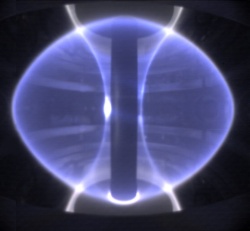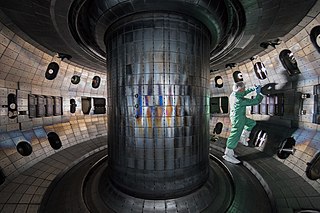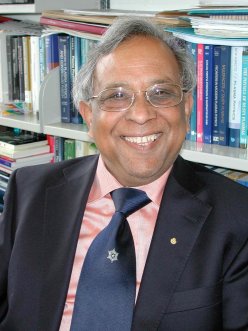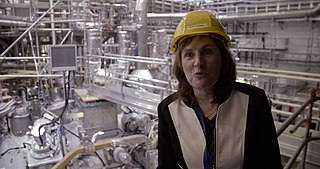Related Research Articles

Princeton Plasma Physics Laboratory (PPPL) is a United States Department of Energy national laboratory for plasma physics and nuclear fusion science. Its primary mission is research into and development of fusion as an energy source. It is known for the development of the stellarator and tokamak designs, along with numerous fundamental advances in plasma physics and the exploration of many other plasma confinement concepts.

Magnetic confinement fusion (MCF) is an approach to generate thermonuclear fusion power that uses magnetic fields to confine fusion fuel in the form of a plasma. Magnetic confinement is one of two major branches of controlled fusion research, along with inertial confinement fusion.

DIII-D is a tokamak that has been operated since the late 1980s by General Atomics (GA) in San Diego, USA, for the U.S. Department of Energy. The DIII-D National Fusion Facility is part of the ongoing effort to achieve magnetically confined fusion. The mission of the DIII-D Research Program is to establish the scientific basis for the optimization of the tokamak approach to fusion energy production.

Padma Kant Shukla was a distinguished Professor and first International Chair of the Physics and Astronomy Department of Ruhr-University Bochum in Germany. He was also the director of the International Centre for Advanced Studies in Physical Sciences at Ruhr-University Bochum. He held a PhD in physics from Banaras Hindu University in Varanasi, India and a second doctorate in Theoretical Plasma Physics from Umeå University in Sweden.
Derek Charles Robinson FRS was a physicist who worked in the UK fusion power program for most of his professional career. Studying turbulence in the UK's ZETA reactor, he helped develop the reversed field pinch concept, an area of study to this day. He is best known for his role in taking a critical measurement on the T-3 device in the USSR in 1969 that established the tokamak as the primary magnetic fusion energy device to this day. He was also instrumental in the development of the spherical tokamak design though the construction of the START device, and its follow-on, MAST. Robinson was in charge of portions of the UK Atomic Energy Authority's fusion program from 1979 until he took over the entire program in 1996 before his death in 2002.
John Morgan Greene was an American theoretical physicist and applied mathematician, known for his work on solitons and plasma physics.
Nicholas Krall is an American theoretical plasma physicist. Dr Krall has authored over 160 science publications and has contributed to the fields of electron scattering, plasma stability, high energy nuclear physics and magnetohydrodynamics. He has worked at General Atomics, the University of California, San Diego, the Naval Research Laboratory and University of Maryland.

Sir Steven Charles Cowley is a British theoretical physicist and international authority on nuclear fusion and astrophysical plasmas. He has served as director of the United States Department of Energy (DOE) Princeton Plasma Physics Laboratory (PPPL) since 1 July 2018. Previously he served as president of Corpus Christi College, Oxford, since October 2016. and head of the EURATOM / CCFE Fusion Association and chief executive officer of the United Kingdom Atomic Energy Authority (UKAEA).
Robert James Goldston is a professor of astrophysics at Princeton University and a former director of the Princeton Plasma Physics Laboratory.

Sibylle Günter is a German theoretical physicist researching tokamak plasmas. Since February 2011, she has headed the Max Planck Institute for Plasma Physics. In October 2015, she was elected a member of the Academia Europaea in recognition of her contribution to research.
Miklos Porkolab (born March 24, 1939) is a Hungarian-American physicist specializing in plasma physics.
Jose A. Boedo is a Spanish plasma physicist and a researcher at University of California, San Diego. He is an Elected Fellow of the American Physical Society, which was awarded in 2016 for "his ground-breaking contributions to the studies of plasma drifts and intermittent plasma transport in the peripheral region of tokamaks".
Hartmut Zohm is a German plasma physicist who is known for his work on the ASDEX Upgrade machine. He received the 2014 John Dawson Award and the 2016 Hannes Alfvén Prize for successfully demonstrating that neoclassical tearing modes in tokamaks can be stabilized by electron cyclotron resonance heating, which is an important design consideration for pushing the performance limit of the ITER.
Tihiro Ohkawa was a Japanese physicist whose field of work was in plasma physics and fusion power. He was a pioneer in developing ways to generate electricity by nuclear fusion when he worked at General Atomics. Ohkawa died September 27, 2014, in La Jolla, California, at the age of 86.
Dmitri Dmitriyevich Ryutov is a Russian theoretical plasma physicist.
Keith Howard Burrell is an American plasma physicist.
Cynthia Elizabeth Kieras Phillips was an American physicist known for her work on plasma, and on the use of radio waves to heat plasma for applications in magnetic confinement fusion.
Elena V. Belova is a former Soviet and American physicist whose research involves the computer simulation of plasma, with applications ranging from the control of heat in tokamak-based fusion power to improved understanding of jets and spheromaks in the solar corona. She works for the United States Department of Energy as a principal research physicist at the Princeton Plasma Physics Laboratory in New Jersey.
Rajesh Maingi is a physicist known for his expertise in the physics of plasma edges and program leadership in the field of fusion energy. He is currently the head of Tokamak Experimental Sciences at the U.S. Department of Energy's (DOE) Princeton Plasma Physics Laboratory (PPPL). He is a Fellow of both the American Physical Society and the American Nuclear Society and has chaired or co-chaired numerous national and international conferences.
Raffi M. Nazikian is a physicist known for his contributions to nuclear fusion research and plasma physics. He has been associated with the Princeton Plasma Physics Laboratory (PPPL) and has conducted significant work at the DIII-D National Fusion Facility.
References
- 1 2 3 "Curriculum Vitae – Richard John Buttery" (PDF). www.ipp.cas.cn. Retrieved January 26, 2024.
- ↑ Fusion Power Associates (October 1, 2020). "Buttery Named Director of DIII-D National Fusion Program at GA". qedfusion.org. Retrieved January 26, 2024.
- 1 2 3 4 5 Polisar, Evan (March 17, 2022). "Meet Richard Buttery, Director of the DIII-D National Fusion Facility". U.S. Department of Energy Office of Science. Retrieved January 26, 2024.
- 1 2 "APS Fellow Archive". www.aps.org. Retrieved January 26, 2024.
- ↑ "The University of Manchester - Library Search". www.librarysearch.manchester.ac.uk. Retrieved January 27, 2024.
- ↑ Buttery, Richard John (1994). "The photon fragmentation function". ProQuest. Retrieved January 27, 2024.
- ↑ Johal, Zabrina (October 23, 2019). "General Atomics Researcher Named Fellow of the American Physical Society". General Atomics. Retrieved January 26, 2024.